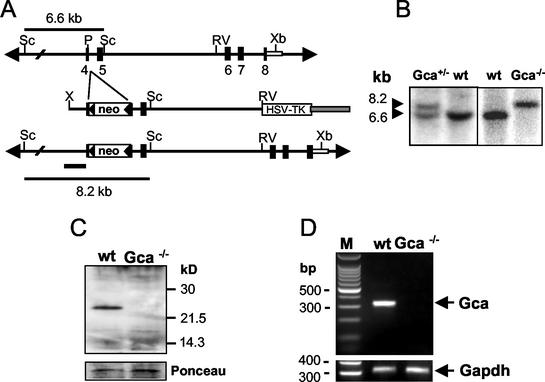FIG. 1.
Generation of grancalcin (Gca)-deficient mice. (A) Targeted inactivation of the grancalcin gene (Gca) in mouse ES cells. Shown is the structure of the Gca gene locus (top), the targeting vector (middle), and the Gca locus after homologous recombination (bottom). Exons 4 to 8 encode EF hands 2 to 5. The insertion of the neo gene into exon 4 disrupts EF hand 2 near its N terminus. Skipping exon 4 during splicing would result in a frameshift mutation. Open boxes, neomycin resistance and herpes simplex virus thymidine kinase (HSV-TK) genes; Sc, ScaI; P, PstI; RV, EcoRV; Xb, XbaI; X, XhoI. (B) Southern blot analysis of ScaI-restricted genomic DNA from the targeted ES cell clone used to generate chimeras (left) and of genomic DNA from a wild-type (wt) and Gca-deficient mouse (right). The probe fragments used are indicated in panel A (bars). (C) Western blot analysis of grancalcin expression in bone marrow of control and mutant mice. Membranes were probed with rabbit anti-mouse grancalcin antiserum raised against a synthetic peptide sequence in the first EF hand. Bottom, Ponceau S-stained membranes to confirm equivalent sample loading for wild-type and mutant mice. (D) RT-PCR of bone marrow RNA to determine levels of mRNA encoding grancalcin (302-bp product [top]) and GAPDH (309-bp product [bottom]) as a control. Grancalcin primers were specific for sequences in exons 2 and 5 flanking the mutated exon. No functional or aberrantly spliced mRNA is detectable in the mutants. Lane M, marker.

